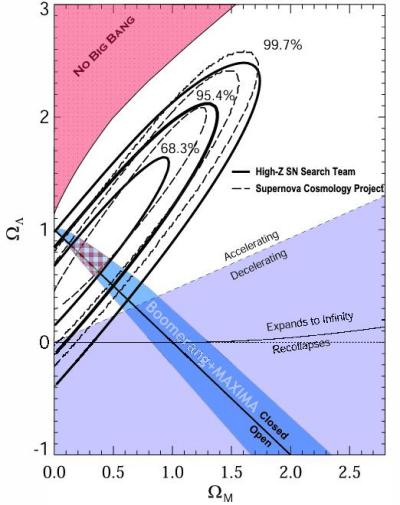High-Z Supernova Search
Table of ContentsThe Expanding Universe
The Fate of the Universe
Supernovae
Type Ia Supernovae
Searching for Distant Type Ia Supernovae
Search Results [1] [2] [3] [4]
Search Conclusions
Data and Discovery
Supernovae are not the only way to make such a diagram. Another way is to look at the Universe when it was very young, and glowed like the sun. This radiation is the furthest thing we can see in the Universe, and is known as the Cosmic Microwave Background. By observing how the lumps and bumps in this background are distributed, it is possible to measure the amount of matter in the Universe. New measurements from this method give their own measurement of Matter and Cosmological Constant.If we combine the two measurement into one diagram, we can figure out what both methods together are telling us right now. As you can see the best values (the hashed red and white area where the two methods overlap) are having normal matter 0.2 of the critical value, and the cosmological constant about 0.8 of the critical value.

The measurements obtained by the High-Z SN Search, the Cosmology Project and the Boomerang MAXIMA Cosmic Microwave Radiation Program plotted on one graph.
Two teams, the High-Z SN Search and the Supernova Cosmology Project have been working on this project. We have both arrived simultaneously, using different data, at almost identical conclusions, without knowledge of each other's results. The diagrams presented here and on the preceeding page, show both team's data. But just because we get the same answer does not mean we are both right. We could both be being fooled by our supernovae in the same way. Or maybe our whole cosmological model is flawed.

